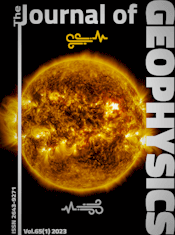Measurement of magnetic susceptibility anisotropy in Buntsandstein deposits from southern Germany
Article Sidebar

Vols. 1-18 (1924-1944), ISSN 0044-2801
Main Article Content
Abstract
The anisotropy of magnetic low-field susceptibility in the Triassic Plattensandstein formation (Upper Buntsandstein) from northern Bavaria has a typical sedimentary fabric. The anisotropy ellipsoids are strongly oblate with minimum susceptibility axes normal to sedimentary bedding. The directions of the maximum susceptibility axes are consistent with the NNE-NE-trending general sediment transport direction that is derived from geological field observations of cross-bedding structures in the sandstones. However, the very small intensity differences between maximum and intermediate susceptibility require extremely sensitive measurement techniques. Comparative measurements were made with a spinner magnetometer, a cryogenic magnetometer and a susceptibility bridge. Directionally, the most consistent results were obtained with the spinner magnetometer after it was stabilized by means of a low-pass active filter. The directional consistency of the anisotropy principal axes can be improved further by annealing the sandstones at 750° C in air. During this treatment a strongly magnetic, low-coercivity mineral phase - probably magnetite - is formed which enhances the degree of magnetic anisotropy as well as the bulk susceptibility. Low temperature measurements indicate that, in the natural unheated state, paramagnetic minerals contribute substantially to the low-field susceptibility of the sandstones at room temperature.
 ARK: https://n2t.net/ark:/88439/y006806
ARK: https://n2t.net/ark:/88439/y006806
Permalink: https://geophysicsjournal.com/article/220
Article Details
References
Argenton, H., Bobier, C., Polveche, J. (1975) La mesure de l'anisotropie de susceptibilite magnetique dans Jes flysches: application a la recherche des directions des paleocourrants. Sediment. Geol. 14:149-167
Bleil, U., Petersen, N. (1982) Magnetic properties of minerals. In: Angenheister, G. (Ed.) Physical properties of rocks, pp 308-365 Springer, Berlin-Heidelberg-New York
Channell, J., Heller, F., Stuijvenberg, J. van (1979) Magnetic susceptibility anisotropy as an indicator of sedimentary fabric in the Gurnigel Flysch. Eclog. Geol. Helv. 73:781-787
Collinson, D.W. (1965) The origin ofremanent magnetization and initial susceptibility of certain red sandstones. - Geophys. J. R. Astron. Soc. 9:203-217
Collinson, D.W. (1968) Ferrous and ferric iron in red sediments and their magnetic properties. Geophys. J. R. Astron. Soc. 16:531-542
Crimes, T.P., Oldershaw, M.A. (1967) Paleocurrent determinations by magnetic fabric measurements of the Cambrian rocks of St. Tudwal's Peninsula, North Wales. Geol. J. 5:217-232
Dunlop, D.J. (1972) Magnetic mineralogy of unheated and heated red sediments by coercivity spectrum analysis. Geophys. J. R. Astron. Soc. 27:37-55
Fisher, R.A. (1953) Dispersion on a sphere. Proc. Roy. Soc. London, A217:295-305
Galehouse, J.S. (1968) A test of the method using the anisotropy of magnetic susceptibility as a paleocurrent indicator. Geol. Soc. Am. Bull. 79:387-390
Hamilton, N. (1967) The effect of magnetic and hydrodynamic control on the susceptibility anisotropy of redeposited silt. J. Geol. 75:738-743
Hamilton, N., Rees, A.I. (1971) The anisotropy of magnetic susceptibility of the Franciscan rocks of the Diablo Range, Central California. Geol. Rdsch. 60:1103-1124
Hamilton, N., Owens, W.H., Rees, A.I. (1968) Laboratory experiments on the production of grain orientation in shearing sand. J. Geol. 76:465-472
Hrouda, F., Janak, F. (1971) A study of the hematite fabric of some red sandstones on the basis of their magnetic. susceptibility anisotropy. Sediment. Geol. 6:187-199
Ising, G. (1942) On the magnetic properties of varved clay. Ark. Math. Astr. Phys. 29A:1-37
Jelinek, V. (1973) Precision a.c. bridge set for measuring magnetic susceptibility of rocks and its anisotropy. Studia Geophys. Geod. 17:36-47
Jelinek, V. (1977) The statistical theory of measuring anisotropy of magnetic susceptibility of rocks and its application. Geofyzika Brno, 88p
Rad, U. von (1970) Comparison between "magnetic" and sedimentary fabric in graded and cross-laminated sand layers, Southern California. Geol. Rdsch. 60:331-354
Rees, A.I. (1961) The effect of water currents on the magnetic remanence and anisotropy of susceptibility of some sediments. Geophys. J. R. Astron. Soc. 5:251
Rees, A.I. (1965) The use of the anisotropy of magnetic susceptibility in the estimation of sedimentary fabric. Sedimentology 4:257-271
Rees, A.I. (1968) The production of preferred orientation in a concentrated dispersion of elongated and flattened grains. J. Geol. 76:457-465
Rees, A.I., Rad, U. von, Shepard, F.P. (1968) Magnetic fabric of sediments from the La Jolla submarine canyon and fan. Marine Geology 6:145-178
Scriba, H., Heller, F. (1978) Measurements of anisotropy of magnetic susceptibility using inductive magnetometers. J. Geophys. 44:341-352
Shive, P.N., Steiner, M.B., Huycke, D.T. (1984) Magnetostratigraphy, paleomagnetism, and remanence acquisition in the Triassic Chugwater formation of Wyoming. J. Geophys. Res. 89:1801-1815
Stephenson, A. (1967) The effect of heat treatment on the magnetic properties of Old Red Sandstone. Geophys. J. R. Astron. Soc 13:425-440
Teyssen, T., Vossmerbaumer, H. (1980) Schragschichtungsanalyse am Beispiel des Buntsandsteins in Nordbayern. N. Jb. Geol. Palaont. Mh. 10:620-642
Turner, P. (1980) Continental red beds. Developments in Sedimentology, 29, pp 1-562. Elsevier, Amsterdam
Van den Ende, C. (1975) On the origin of anisotropy of magnetic susceptibility in the Permian red beds from the western parts of the Dome de Barrot (S. France). In: Borradaile, G.J. et al. (Eds.) Progress in geodynamics, Proc. Nat. Symp. Geodynamics. pp 176-189
Vossmerbaumer, H., Achtnich, T., Kistner, A., Priebe, H., Rongitsch, A., Ruckert, E., Schultz, T., Teyssen, T. (1979) Schuttungsrichtungen im Plattensandstein (Trias, Oberer Buntsandstein) Frankens. Geol Bl. NO-Bayern 29:50-6
Wurster, P. (1958) Geometrie und Geologie von Kreuzschichtungskorpern. Geol. Rdsch. 47:322-359











